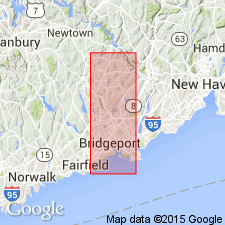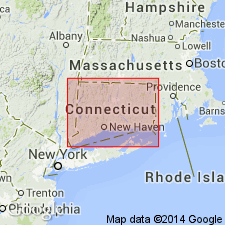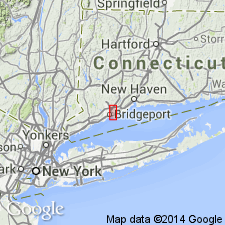
- Usage in publication:
-
- Beardsley Gneiss Member
- Modifications:
-
- Original reference
- Dominant lithology:
-
- Gneiss
- AAPG geologic province:
-
- New England province
Summary:
Pg. 32-33. Beardsley Gneiss Member of Prospect Formation. Consists of homogeneous gneiss with pink pegmatite veins. Overlies Pumpkin Ground Member (new) of Prospect Formation; underlies Ansonia Gneiss; interfingers with Golden Hill Schist Member (new) of Prospect Formation. Age is Middle and Late Ordovician.
Type locality: hills of Beardsley Park east of Bunnels Pond, Bridgeport, Fairfield Co., southwestern CT.
Source: US geologic names lexicon (USGS Bull. 1520, p. 22).

- Usage in publication:
-
- Beardsley Member*
- Modifications:
-
- Age modified
- AAPG geologic province:
-
- New England province
Summary:
The Beardsley Member, as revised by Rodgers (1982) on the preliminary geologic map of CT, is accepted for usage by the USGS on the State geologic map of CT, prepared in cooperation with the State geological survey. Unit is a member of the Harrison Gneiss or the Prospect Gneiss in the Hartland belt of the Connecticut Valley synclinorium in CT. The age of the Beardsley is modified to Middle Ordovician(?).
Source: GNU records (USGS DDS-6; Reston GNULEX).

- Usage in publication:
-
- Beardsley orthogneiss
- Modifications:
-
- Revised
- Redescribed
- Age modified
- Geochronologic dating
- AAPG geologic province:
-
- New England province
Summary:
Pumpkin Ground and Beardsley Members of Harrison Gneiss, formerly considered conformable metavolcanic members, are here recognized as juxtaposed metaplutonic units and are renamed the Beardsley and Pumpkin Ground orthogneisses. Isotopic dating yields crystallization ages of 428+/-2 Ma (Early Silurian) for the Pumpkin Ground and 446+/-2 Ma (Late Ordovician) for the Beardsley. Age of the Beardsley based on analysis of seven zircon and two sphene fractions. The Harrison Gneiss as described by Rodgers (1985) has no stratigraphic significance and cannot be correlated regionally.
Source: GNU records (USGS DDS-6; Reston GNULEX).
For more information, please contact Nancy Stamm, Geologic Names Committee Secretary.
Asterisk (*) indicates published by U.S. Geological Survey authors.
"No current usage" (†) implies that a name has been abandoned or has fallen into disuse. Former usage and, if known, replacement name given in parentheses ( ).
Slash (/) indicates name conflicts with nomenclatural guidelines (CSN, 1933; ACSN, 1961, 1970; NACSN, 1983, 2005, 2021). May be explained within brackets ([ ]).

